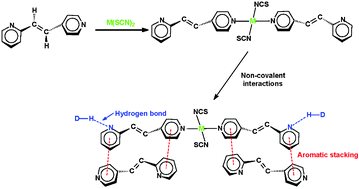A series of new polymeric network complexes [M(bpe)2(SCN)2(CH3OH)(H2O)]
(M = CoII for 1 and NiII for 2), [Cu(bpe)2(SCN)2(CH3OH)]2[Cu(bpe)2(SCN)2]
(3), [Cu(bpe)2(SCN)2(H2O)]2−
[Cu(bpe)2(SCN)2]
(4), [Fe(bpe)2(SCN)2(H2O)2]
(5) and [Pb(bpe)(SCN)2]n
(6) have been designed and prepared from solution assembly of trans-1-(2-pyridyl)-2-(4-pyridyl)ethylene (bpe) and metal thiocyanate at room temperature. X-Ray single-crystal structural determination reveals that the 3-D crystal packing of these complexes is mastered by the interplay of coordinative and secondary non-covalent interactions. The hierarchical regulated strategy in metal–organic supramolecular chemistry is successfully utilized in the rational construction of these architectures, which are, interestingly, influenced by the variation of the concerned assembled elements such as metal ion and solvent medium. The coordination chemistry of thiocyanate ion, especially with PbII, is also summarized.
You have access to this article
 Please wait while we load your content...
Something went wrong. Try again?
Please wait while we load your content...
Something went wrong. Try again?


 Please wait while we load your content...
Please wait while we load your content...